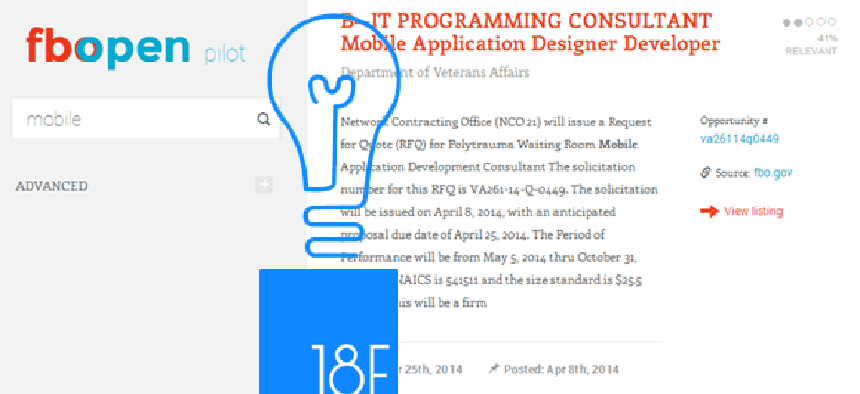18F team delivers tools for next-gen digital government


Connecting state and local government leaders
GSA's new center of innovation has released more than 20 open source code repositories to help agencies deliver user-centric digital services to the people and businesses they serve.
This article was changed April 11 to clarify the contents of the 18F Github repository.
As the government takes steps toward its Digital Government Strategy and Open Data Policy, a new program at the General Services Administration called 18F has taken shape to become a center of digital agency innovation.
Announced March 19, the program – named after GSA’s headquarters at 18th and F streets in Washington, D.C. – has gathered a team of 15 public- and private-sector digital technologists to create and release new software tools to support a range of public, commercial and government applications.
More than 20 open source code repositories generated by 18F are now available at github.com/18F. FBOpen is one of them. It’s an open API server, which offers data import tools and sample apps to help small businesses search for opportunities to work with the U.S. government,. The developers with the 18F program are taking data from the Federal Business Opportunities’ website, FBO.gov, and wrapping it in an open API server, and making the data searchable with a simple query. 18F also built a representational state transfer (REST) API for users to build their own query tools.
The result is source code that can be downloaded, updated and improved. It provides new functionality for small businesses that had difficulty finding this information before. Other 18F projects include AFRL SBHub, the Air Force Research Laboratory’s effort to connect with small businesses, and PricesPaidGUI, part of a market research tool to enable search of purchases.
The new program is on the right track, said Kin Lane, an API evangelist and former Presidential Innovation Fellow. “They tell the story of what they’re doing, what each agency is facing when it comes to pulling APIs, what are best practices,” he said. Telling the story means providing a road map of the genesis of the API, how it was developed, how to use it and what it can do.
Lane also praised 18F’s use of GitHub, a social coding site, particularly the API-All-the-X project. “This is their central organizing, kind of landing page, so they’re organizing all the resources they would use to deploy projects and do things but they’re also telling it to publish here, telling it so other agencies can follow,” Lane said of API-All-the-X.
He cited FBOpen as a example of what 18F and open APIs can do. “The ultimate example of what is possible with the FBOpen API, is the fact that they use it for driving the FBOpen website,” Lane wrote on his API Evangelist blog. “Nothing shows developers the value that an API delivers … than seeing API providers use their own API. When government agencies use their own APIs it sends the right signal to developers, while also helping agencies see what developers face when putting government API resources to use.”
Agencies can use 18F’s offerings for a variety of projects, Lane said. For instance, the Veterans Affairs Department could use it for its Facilities API, which has a list of all the health care facilities in the country. Through API-All-the-X, other agencies could find tools and resources for similar work or get connected through a forum or a DC API meetup to talk to about a project.
“All of that’s here for any agency no matter what the project is, whether it’s a basic data set that they want to release or a more advanced API, something like a procurement system from one of the agencies,” Lane said.
The government is moving toward APIs and more openness, which is a good thing, he said, considering the story of HealthCare.gov and the controversy surrounding it. Had an organization like 18F been in place when HealthCare.gov was launching, things might have gone smoother, Lane said.
“If you look at the front end, the website for HealthCare.gov, it was deployed actually in this model,” Lane said. “It was deployed on GitHub using what’s called Jekyll for the content management system and much of the data around it was done with an API, but the problem is the back-end systems were all the same old procurement process, government [information technology] -- super costly.”




